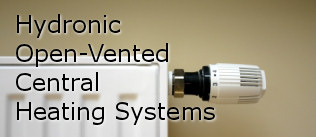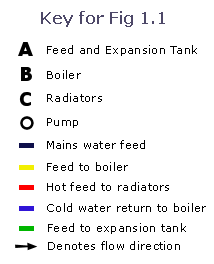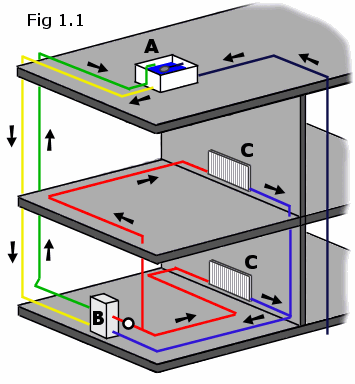Hydronic open-vented central heating system

This type of central heating system is one of the most common found in homes today. In this section we will look at the system in action, and try to give you a better idea of how the system works.
Our example below is a very basic system, but will allow us to explain the fundamentals.
Our example below is a very basic system, but will allow us to explain the fundamentals.
First, let's look at some facts about heating systems in general.
Advertisements
Hot water is lighter than cold water, and therefore rises (in the same way that hot air rises). Older hydronic heating systems relied solely on this to circulate the water. The hot water would rise to the top, the radiators would dissipate the heat, and then the cooled water would return back down to the boiler due to gravity.
Modern hydronic systems still use the same principle, except that a pump is normally used to help circulate the water to the radiators in the system.
Another important fact is that water expands when it reaches a certain temperature. All hydronic heating systems use some sort of device to handle the expansion of the water. In an open-vented system, the device used is called an expansion tank. The expansion tank is always found at the highest point in the system, as that is where the hottest water will go.
A hydronic heating system must get its water from somewhere, and this would usually be the mains water supply. In an open-vented system the expansion tank doubles as the water supply. It uses a float ball and ballcock to control the water level (similar to what you would find in your toilet tank (cistern)).
Modern hydronic systems still use the same principle, except that a pump is normally used to help circulate the water to the radiators in the system.
Another important fact is that water expands when it reaches a certain temperature. All hydronic heating systems use some sort of device to handle the expansion of the water. In an open-vented system, the device used is called an expansion tank. The expansion tank is always found at the highest point in the system, as that is where the hottest water will go.
A hydronic heating system must get its water from somewhere, and this would usually be the mains water supply. In an open-vented system the expansion tank doubles as the water supply. It uses a float ball and ballcock to control the water level (similar to what you would find in your toilet tank (cistern)).
The basic hydronic open-vented central heating system


The system shown in fig 1.1 is a simplified version, but shows the basic operation.
The heating process
- The water enters the system via the feed & expansion tank (A)
- The ball float and ballcock control the water levels
- The water then feeds down to the boiler (B) via the feed pipe (yellow)
- The boiler heats the water, which is then pumped to the radiators (C) through the feed pipes (red)
- Once the water in the radiators cools, it returns to the boiler via the return pipes (blue)
- The boiler reheats the water, which is then pumped back to the radiators
- If the water gets too hot and expands too much, it rises to the expansion tank via the expansion pipe (green). It will eventually cool and enter the system again.
How to drain the open-vented central heating system
Draining an open-vented central heating system is fairly straightforward.
You will find a draincock, usually situated on the return pipe (blue in our diagram), which is used to drain the water from the system.
You will need a rubber hose long enough to reach an outside drain from the draincock.
Below are the steps for draining a hydronic open-vented central heating system.
You will find a draincock, usually situated on the return pipe (blue in our diagram), which is used to drain the water from the system.
You will need a rubber hose long enough to reach an outside drain from the draincock.
Below are the steps for draining a hydronic open-vented central heating system.
Advertisements
- Turn off the boiler but leave the pump on, as this will allow the water in the system to cool.
- Once the water is cooled, turn off the pump.
- Next we need to turn off the water supply to the system (in the loft). Some systems will have a stopcock on the main feedpipe, which can be turned to stop the flow. If there is no stopcock you can disable the ball-valve. This can be done by fixing the ball-valve arm (the rod with the ball on the end) in the level position. To keep the arm in place, you can place a piece of batten across the top of the tank with the ball-valve arm resting on the top. Secure the ball-valve arm to the batten with a piece of string.
- Place one end of the rubber hose securely onto the draincock (found on the return pipe near the boiler). The other end of the hose should be placed outside in a gully or drain.
- Open the draincock (use an adjustable spanner if you don't have a key) and the system will start to drain.
- Some water will be left in the system because of the vacuum that is created within the radiators. The remaining water can be released by opening the bleed-valves on the radiators. Open the bleed-valve on one radiator at a time, starting with the radiators at the top of the building.
- note: inverted pipe loops will need to be drained individually after the main system has been drained. Inverted loops have their own draincock (see fig 1.2 below).
Inverted pipe loop
An inverted pipe loop is created when both of the pipes come down to the radiator from the ceiling void or top of the wall.
Inverted loops are common when central heating has been installed after construction. They can usually be found in older buildings with solid concrete floors.
These loops should be drained after you have drained the rest of the system, as described above.
Inverted loops are common when central heating has been installed after construction. They can usually be found in older buildings with solid concrete floors.
These loops should be drained after you have drained the rest of the system, as described above.
Filling the open-vented heating system
An open-vented heating system is filled via the feed & expansion tank. The filling process should be completely automated and the ball float and ballcock will control the filling process.
If you have just drained the system, ensure you have closed all of the radiator bleed valves and the draincock. If you have used our guide, turn the stopcock back on or untie the ball-valve arm.
The system will start to fill and when it has reached the optimum level, the ball-valve will close.
The heating system will almost certainly need bleeding to release any trapped air. Start bleeding the radiators on the bottom floor first, then work your way up to the top floor.
The circulating pump may also need bleeding, you will find a bleeding screw on the side of the pump.
If you have just drained the system, ensure you have closed all of the radiator bleed valves and the draincock. If you have used our guide, turn the stopcock back on or untie the ball-valve arm.
The system will start to fill and when it has reached the optimum level, the ball-valve will close.
The heating system will almost certainly need bleeding to release any trapped air. Start bleeding the radiators on the bottom floor first, then work your way up to the top floor.
The circulating pump may also need bleeding, you will find a bleeding screw on the side of the pump.
Advertisements
